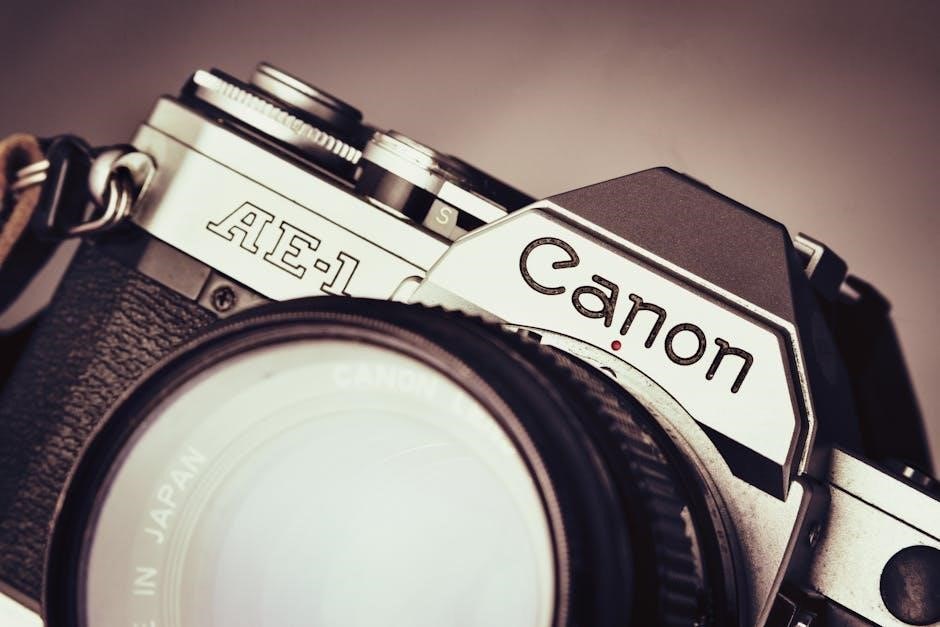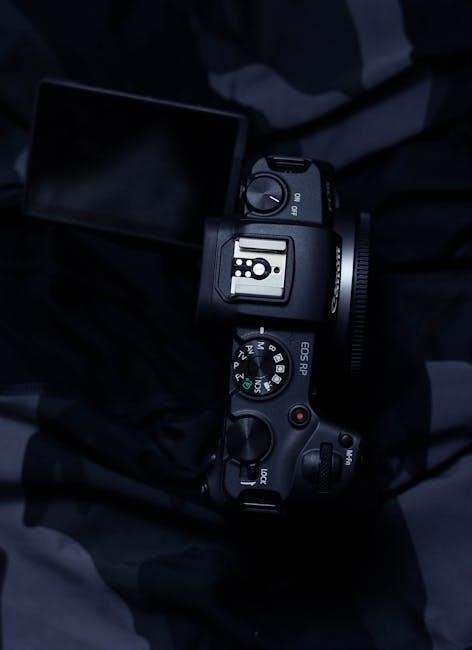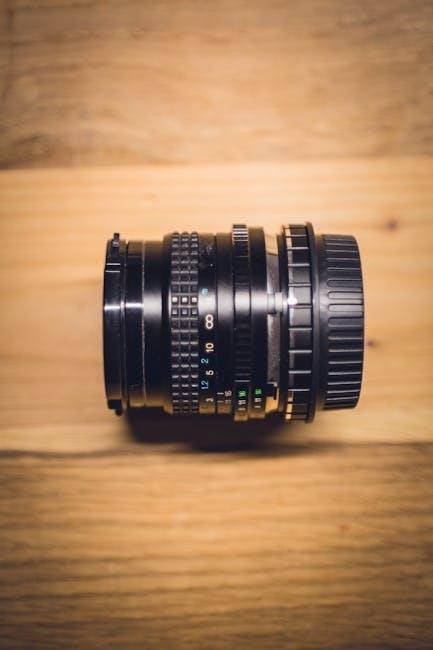Welcome to the Canon EOS 1300D manual, your comprehensive guide to mastering this DSLR camera. This manual provides detailed instructions to help you understand and utilize the camera’s features effectively, ensuring you capture stunning images with ease. Discover how to navigate menus, adjust settings, and unlock advanced photography techniques for optimal results.
1.1 Overview of the Canon EOS 1300D Camera
The Canon EOS 1300D is an entry-level DSLR camera designed for photography enthusiasts. It features an 18.0 MP APS-C CMOS sensor, DIGIC 4 Image Processor, and a 9-point AF system for precise focus. The camera supports Full HD video recording, manual controls, and wireless connectivity via Wi-Fi and NFC. It’s ideal for capturing high-quality images and learning advanced photography techniques with ease.
1.2 Importance of Reading the Manual
Reading the Canon EOS 1300D manual is essential to unlock its full potential. It provides detailed instructions on camera settings, shooting modes, and troubleshooting, ensuring optimal performance. The manual helps users understand advanced features, resolve common issues, and enhance their photography skills, making it a vital resource for both beginners and experienced photographers alike.
Key Features of the Canon EOS 1300D
The Canon EOS 1300D features an 18.0 MP APS-C CMOS sensor, DIGIC 4 Image Processor, and a 9-point AF system, delivering crisp images and precise focusing.
2.1 18.0 MP APS-C CMOS Sensor
The Canon EOS 1300D is equipped with an 18.0 MP APS-C CMOS sensor, designed to capture high-resolution images with vibrant colors and reduced noise. This sensor works seamlessly with the DIGIC 4 Image Processor to ensure detailed and lifelike photos, even in challenging lighting conditions, making it ideal for both beginners and enthusiasts seeking quality results.
2.2 DIGIC 4 Image Processor
The DIGIC 4 Image Processor enhances the Canon EOS 1300D’s performance by delivering fast and accurate image processing. It improves noise reduction, especially in low-light conditions, and supports the camera’s autofocus and metering systems. This processor ensures high-quality image output, making it a key component in capturing sharp and detailed photos with minimal noise.
2.3 9-Point AF System with Center Cross-Type AF Point
The Canon EOS 1300D features a 9-Point AF System with a center cross-type AF point for enhanced autofocus accuracy. This system ensures precise focus detection, even in challenging lighting conditions, by covering a wide area of the frame. The cross-type point provides additional sensitivity for critical focus, making it ideal for capturing sharp images of moving subjects or complex compositions.

Technical Specifications of the Canon EOS 1300D
The Canon EOS 1300D features an 18.0 MP APS-C CMOS sensor, DIGIC 4 Image Processor, ISO 100-6400 range, Full HD video recording, and weighs 485g with dimensions of 129x101x78mm.
3.1 Image Sensor Size and Type
The Canon EOS 1300D features an 18.0 MP APS-C CMOS sensor, measuring 22.3 x 14.9mm. This sensor captures light efficiently, delivering high-quality images with excellent dynamic range and color accuracy. Its design ensures vibrant and lifelike colors, while the DIGIC 4 Image Processor enhances image processing for optimal results in various lighting conditions.
3.2 ISO Range and Noise Performance
The Canon EOS 1300D offers an ISO range of 100-6400, extendable to 12800. It delivers decent noise performance, with minimal grain in low-light conditions. While high ISO settings may introduce some noise, the results remain usable for everyday photography. The camera balances noise reduction and detail retention effectively, ensuring sharp and clear images across various lighting scenarios.
3.4 Video Recording Capabilities
The Canon EOS 1300D supports Full HD video recording at 1080p (30fps) and 720p (60fps), captured in MOV format. It features a built-in microphone for audio recording and manual focus control during filming. The camera also offers a Video Snapshot mode, allowing users to capture short clips and combine them into a single movie; Maximum video file size is 4GB, ensuring high-quality footage.

How to Use the Canon EOS 1300D
Mastering the Canon EOS 1300D starts with understanding its basic operation, navigating the intuitive menu system, and exploring its various shooting modes to capture stunning images effortlessly.
4.1 Basic Camera Operation
Start by turning on the camera using the power switch. Select a shooting mode via the mode dial, such as Auto or Manual. Press the shutter button halfway to focus and fully to capture an image. Adjust settings like aperture and shutter speed using the control dials. Use the LCD screen to preview settings and review photos. Refer to the Canon EOS 1300D manual for detailed instructions on these operations.
4.2 Navigating the Camera Menu
Access the menu by pressing the MENU button. Use the arrow keys or multi-controller to navigate through options. Highlight desired settings and press SET to select. Adjust parameters using the control dials or multi-controller. Save changes by pressing SET again. Exit the menu by pressing the MENU button or halfway pressing the shutter button. Refer to the Canon EOS 1300D manual for detailed guidance on menu navigation.
Focusing Techniques with the Canon EOS 1300D
Explore the Canon EOS 1300D’s focusing techniques, including Autofocus modes like 1-shot AF and AI Servo AF, and Manual Focus for precise control in various photography situations.
5.1 Autofocus Modes
The Canon EOS 1300D features a 9-point AF system with a cross-type center point, ensuring precise focus. Choose from modes like 1-shot AF for stationary subjects and AI Servo AF for tracking moving subjects. These modes enhance flexibility in various shooting scenarios, from portraits to action photography, allowing you to capture sharp images effortlessly.
5.2 Manual Focusing
Manual focusing on the Canon EOS 1300D allows precise control over your subject’s sharpness. Use the focus ring on compatible EF-S lenses to adjust focus manually. Enable MF mode via the lens or camera menu. The LCD screen assists in achieving accurate focus, ensuring creativity and control in your photography, especially for macro or portrait shots where autofocus may not suffice.
Image Quality and Settings
The Canon EOS 1300D delivers high-quality images with its 18;0 MP APS-C CMOS sensor and DIGIC 4 processor. Customize settings like resolution, compression, and white balance for optimal results in various lighting conditions.
6.1 Image Resolution and Compression Formats
The Canon EOS 1300D offers multiple resolution settings, including 5184×3456 pixels for maximum detail. It supports JPEG compression formats in Fine, Normal, and RAW modes. Fine mode retains high quality, while Normal compresses files for storage efficiency. RAW format captures uncompressed data for advanced editing. Choose the best format and resolution to suit your needs, ensuring optimal image quality and flexibility for post-processing;
6.2 White Balance and Color Settings
The Canon EOS 1300D allows precise control over white balance and color settings. Choose from preset modes like Auto, Daylight, Shade, Tungsten, and Fluorescent to match lighting conditions. Custom White Balance enables setting a specific white point for accurate color rendition. Additionally, color spaces such as sRGB and Adobe RGB are available for consistent color reproduction across devices. The manual guides adjusting these settings for optimal results.

Connectivity and Sharing Options
The Canon EOS 1300D offers seamless wireless connectivity via Wi-Fi and NFC, enabling easy image transfer to computers, smartphones, and online platforms for instant sharing and backup solutions.
7;1 Wi-Fi and NFC Connectivity
The Canon EOS 1300D features built-in Wi-Fi and NFC capabilities, enabling quick and seamless wireless connectivity. Users can easily transfer images to computers, smartphones, or online platforms. NFC allows for one-touch connection with compatible devices, simplifying photo sharing and remote camera control. The manual provides detailed guidance on setting up these features for efficient and convenient image management.
7.2 Transferring Images to a Computer
Transferring images from the Canon EOS 1300D to a computer is straightforward. Use a USB cable to connect directly or insert the memory card into a card reader. The camera also supports wireless transfer via Wi-Fi. Canon’s software, like Image Transfer Utility, simplifies the process. The manual provides step-by-step instructions for both wired and wireless methods, ensuring efficient image backup and organization.
Advanced Shooting Modes
Unlock creative control with the Canon EOS 1300D’s advanced shooting modes, including Manual (M), Aperture Priority (Av), and Shutter Priority (Tv), enabling precise exposure adjustments for professional results.
8.1 Manual (M) Mode
Manual (M) Mode offers full creative control, allowing you to independently adjust both aperture and shutter speed. This mode is ideal for experienced photographers who want precise control over exposure settings to achieve desired artistic effects. Use the camera’s dials to set aperture and shutter speed, ensuring optimal results in various lighting conditions. Experiment confidently with manual controls for professional-grade photography.
8.2 Aperture Priority (Av) and Shutter Priority (Tv) Modes
Aperture Priority (Av) mode allows you to set the aperture, while the camera automatically adjusts the shutter speed for proper exposure. Shutter Priority (Tv) mode lets you set the shutter speed, with the camera adjusting the aperture. Both modes offer flexibility, enabling control over depth of field or motion effects while the camera manages the other exposure parameter, simplifying creative photography.

Maintenance and Troubleshooting
Regular cleaning of the sensor and lens, proper storage, and checking for firmware updates help maintain the Canon EOS 1300D. Addressing common issues like battery performance ensures optimal functionality and longevity.
9.1 Cleaning and Care Tips
Regularly clean the camera’s sensor and lens with a soft, dry cloth to prevent dust and smudges. Avoid harsh chemicals and ensure the camera is stored in a dry, cool place. Use a protective bag to safeguard against scratches and moisture. Periodically check and clean the memory card slots and battery compartment for optimal performance and longevity.
9.2 Common Issues and Solutions
Address common issues like blurry images by ensuring autofocus accuracy and clean lenses. For memory card errors, format the card or check connections. Resolve battery life concerns by charging properly and avoiding extreme temperatures. If issues persist, refer to the troubleshooting section or contact Canon support for further assistance and solutions.
